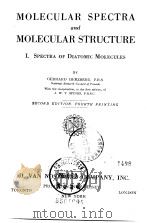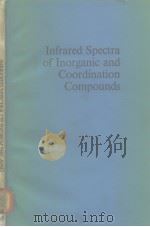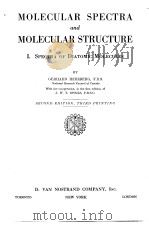《Molecular vibrations the theory of infrared and raman vibrational spectra.》
| 作者 | 编者 |
|---|---|
| 出版 | 未查询到或未知 |
| 参考页数 | 388 |
| 出版时间 | 没有确切时间的资料 目录预览 |
| ISBN号 | 无 — 求助条款 |
| PDF编号 | 811337798(仅供预览,未存储实际文件) |
| 求助格式 | 扫描PDF(若分多册发行,每次仅能受理1册) |

CHAPTER 1.INTRODUCTION1
1-1.Infrared Spectra1
1-2.Raman Spectra3
1-3.The Molecular Model4
1-4.Classical Theory of Vibrational and Rotational Spectra6
1-5.The Quantum Viewpoint7
1-6.Applications9
CHAPTER 2.THE VIERATION OF MOLECULES11
2-1.Separation of Rotation and Vibration11
2-2.Small Vibrations in Classical Mechanics14
2-3.Normal Modes of Vibration17
2-4.Normal Coordinates19
2-5.Modes of Motion with Zero Frequency22
2-6.Other Types of Coordinates25
2-7.An Illustration27
2-8.Linear Molecules31
CHAPTER 3.WAVE MECHANICS AND THE VIBRATION OF MOLECULES34
3-1.The Wave Equation for the Vibration of the Harmonic Oscillator Model34
3-2.Description of the Energy Levels of the Harmonic Oscillator35
3-3.Nature of the Wave Functions37
3-4.Selection Rules in Wave Mechanics38
3-5.Infrared Selection Rules and Intensities for the Harmonic Oscillator Model39
3-6.Classical Intensities of Radiation from an Induced Dipole43
3-7.Quantum-mechanical Theory of Raman Intensities48
CHAPTER 4.MORE ADVANCED METRODS OF STUDYING VIBRATIONS54
4-1.Internal Coordinates and Their Relation to Atomic Displacements54
4-2.Construction and Properties of the G Matrix61
4-3.The Secular Equation in Terms of Internal Coordinates63
4-4.A Form of the Secular Equation Convenient for Machine Solution65
4-5.Direct Expansion of the Secular Equation68
4-6.An Example:The Nonlinear Triatomic Molecule69
4-7.Determination of Normal Coordinates71
4-8.Approximate Separation of High and Low Frequencies74
CHAPTER 5.SYMMETRY CONSIDERATIONS77
5-1.The Symmetry of Molecules78
5-2.Groups of Symmetry Operations80
5-3.The Symmetry Point Groups82
5-4.Symmetrically Equivalent Atoms and Subgroups85
5-5.Symmetry of the Potential and Kinetic Energies87
5-6.Representations88
5-7.Symmetry of Normal Coordinates92
5-8.Irreducible Representations97
5-9.Classes of Symmetry Operations99
CHAPTER 6.APPLICATIONS OF GROUP THEORY TO THE ANALYSIS OF MOLECULAR VIBRATIONS102
6-1.Determination of the Characters XR102
6-2.Symmetry and Degeneracy of the Normal Modes106
6-3.Factoring of the Secular Equation113
6-4.Construction of Internal Symmetry Coordinates117
6-5.External Symmetry Coordinates125
6-6.The Potential and Kinetic Energies in Terms of Symmetry Coordinates127
6-7.Correlation Tables and the Treatment of Internal Coordinate Sets in which n(r)>1135
6-8.Removal of Redundant Coordinates140
CHAPTER 7.VIBRATIONAL SELECTION RULES AND INTENSITIES146
7-1.Symmetry of Wave Functions147
7-2.Symmetry of Combination Levels148
7-3.Symmetry Species of Overtone Levels151
7-4.Symmetry Species of a General Vibrational Level155
7-5.Symmetry of the Components of the Electric Moment156
7-6.The Transformation Properties of the Components of the Polarizability157
7-7.Determination of Selection Rules for Infrared Absorption159
7-8.Selection Rules for the Raman Effect161
7-9.Absolute Infrared Absorption Intensities of Fundamentals162
CHAPTER 8.POTENTIAL FUNCTIONS169
8-1.The General Quadratic Potential Function169
8-2.The Approximation of Central Forces173
8-3.The Approximation of Valence Forces174
8-4.Modification of the Simple Force Functions177
8-5.The Isotope Effect182
8-6.Anharmonic Terms in the Potential Energy193
8-7.Quantum-mechanical Resonance197
8-8.Vibrations of Molecules with Several Equilibrium Positions200
8-9.Molecules with Internal Rotation202
CHAPR 9.METHODS OF SOLVING THE SECULAR DETERMINANT208
9-1.Characteristic Values and Characteristic Vectors209
9-2.Symmetrization of the Secular Determinant211
9-3.Solution by Direct Expansion of the Secular Determinant214
9-4.Indirect Expansion of the Secular Determinant215
9-5.Solution by Evaluation of the Determinant218
9-6.Rayleigh’s Principle218
9-7.Solution of the Simultaneous Equations222
9-8.Matrix Iteration Methods226
9-9.Perturbation Methods229
9-10.Use of Electric Circuit Analogues232
CHAPTER 10.A SAMPLE VIBRATIONAL ANALYSIS:THE BENZENE MOLECULE240
10-1.Structure and Symmetry of the Benzene Molecule240
10-2.Symmetry Species of Normal Coordinates and Internal Coordinates241
10-3.Selection Rules244
10-4.Isotopically Substituted Benzene and the Product Rule248
10-5.Assignment of Observed Frequencies251
10-6.Potential and Kinetic Energy in Internal Coordinates253
10-7.Symmetry Coordinates257
10-8.Factored Potential and Kinetic Energy Matrices260
10-9.Expansion of Secular Equation265
10-10.Calculation of Some Force Constants and Frequencies265
CHAPTER 11.THE SEPARATION OF ROTATION AND VIBRATION273
11-1.Classical Kinetic Energy273
11-2.Hamiltonian Form of Kinetic Energy277
11-3.A General Theorem Concerning Quantum-mechanical Hamiltonians279
11-4.The Quantum-mechanical Hamiltonian for a Molecul281
11-5.Practical Approximations283
APPENDIXES285
Ⅰ.Coordinate Systems and Eulerian Angles285
Ⅱ.Justification of the Procedure used in Section 2-2 for Obtaining Normal Vibrations287
Ⅲ.Hermite Polynomials and Some Integrals Involving the Harmonic Oscillator Wave Functions289
Ⅳ.Averages of Direction Cosines Over All Orientations292
Ⅴ.A Summary of Matrix Notation293
Ⅵ.A Tabulation of G Matrix Elements303
Ⅶ.Connection Between G Matrix and Kinetic Energy307
Ⅷ.Matrix Treatment of Normal Coordinate Problem309
Ⅸ.The Separation of High and Low Frequencies311
Ⅹ.Some Properties of Group Representations;Character Tables and Correlation Tables312
Ⅹ-1.Derivation of Characters for the Cyclic Groups,en312
Ⅹ-2.Character Orthogonality Relations313
Ⅹ-3.Characters of the Dihedral Groups,Dn316
Ⅹ-4.Isomorphic and Direct Product Groups320
Ⅹ-5.Species Notation322
Ⅹ-6.Symmetry Species of Combinations:Direct Products of Ineducible Representations331
Ⅹ-7.Overtones of Degenerate Fundamentals332
Ⅹ-8.Correlation Tables333
Ⅺ.Orthogonality of Irreducible Representation Matrices341
Ⅻ.Proof of the Factoring of the Secalar Determinant347
ⅩⅢ.Reduction of an Irreducible Representation in a Subgroup350
ⅩⅣ.Symmetry Species for the Overtones of Degenerate Fundamentals352
ⅩⅤ.Transformation of the Polarizability Components,axx,axv,etc.359
ⅩⅥ.Rotational Energies and Selection Rules361
INDEX371
《Molecular vibrations the theory of infrared and raman vibrational spectra.》由于是年代较久的资料都绝版了,几乎不可能购买到实物。如果大家为了学习确实需要,可向博主求助其电子版PDF文件。对合法合规的求助,我会当即受理并将下载地址发送给你。
高度相关资料
-

- MOLECULAR SPECTRA and MOLECULAR STRUCTURE
- 1945 D·VAN NOSTRAND COMPANY,INC PRINCETON NEW JERSEY
-

- BIOLOGICAL APPLICATIONS OF RAMAN SPECTROSCOPY VOLUME 2:RESONANCE RAMAN SPECTRA OF POLYENES AND AROMA
- JOHN WILEY & SONS
-

- BIOLOGICAL APPLICATIONS OF RAMAN SPECTROSCOPY VOLUME 3:RESONANCE RAMAN SPECTRA OF HEME AND METALLOP
- 1988年 JOHN WILEY & SONS
-

- INFRARED AND RAMAN SPECTRA OF INORGANIC AND COORDINATION COMPOUNDS
- 1986 JOHN WILEY & SONS
-

- MOLECULAR VIBRATIONS
- 1955
-

- VIBRATIONAL SPECTRA AND STRUCTURE A SERIES OF ADVANCES VOLUME 22 VIBRATIONAL INTENSITIES
- 1996 ELSEVIER
-

- VIBRATIONAL SPECTRA AND STRUCTURE VOLUME 12 A SERIES OF ADVANCES
- 1983 ELSEVIER SCIENCE PUBLISHING COMPANY INC.
-

- INTRODUCTION TO THE THEORY OF MOLECULAR VIBRATIONS AND VIBRATIONAL SPECTROSCOPY
- 1972 OXFORD . AT THE CLARENDON PRESS
-

- VIBRATIONAL SPECTRA AND STRUCTURE OF POLYATOMIC MOLECULES
- 1939 NATIONAL UNIVERSITY OF PEKING KUN-MING CHINA
-

- THE THEORY OF SPECTRA AND ATOMIC CONSTITUTION
- 1922 AT THE UNIVERSITY PRESS
-

- VIBRATIONAL SPECTRA AND STRUCTURE A SERIES OF ADVANCES VOLUME 11
- 1982 ELSEVIER SCIENTIFIC PUBLISHING COMPANY
-

- THE THEORY OF ATOMIC STRUCTURE AND SPECTRA
- 1981 UNIVERSITY OF CALIFORNIA PRESS
提示:百度云已更名为百度网盘(百度盘),天翼云盘、微盘下载地址……暂未提供。➥ PDF文字可复制化或转WORD


